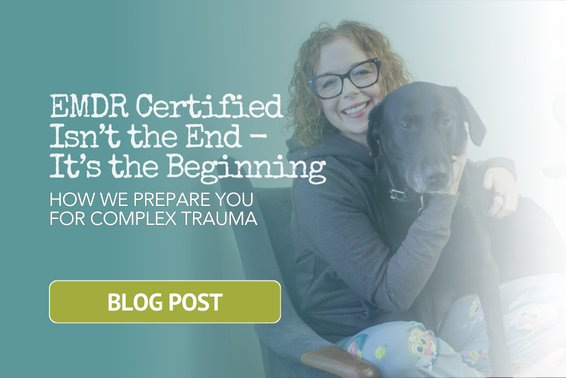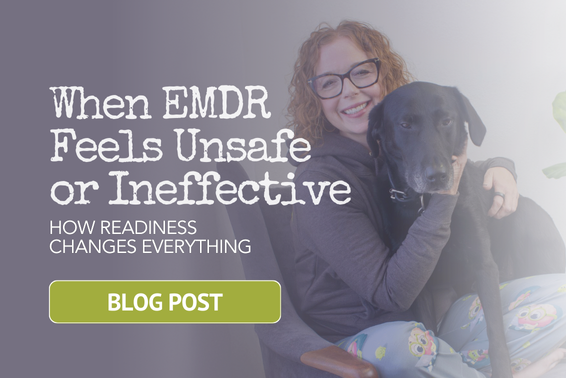
From Imposter Syndrome to Overconfidence
What It Takes to Be a Competent EMDR Therapist
Written by Susie Morgan, LMFT, BCETS - November 16, 2025
Why EMDR Basic Training Alone Doesn’t Make You a Competent or Confident EMDR Therapist
If you’re an EMDR therapist—or on the path to becoming one—you’ve likely found yourself somewhere between “I know what I’m doing” and “What if I don’t belong here at all?” In this conversation, I want to speak directly to that experience: the full range from overconfidence to imposter syndrome and everything in between.
This is an invitation for reflection. Where are you on the confidence spectrum? Where is your growth edge as an EMDR therapist?
The Myth of Arrival: EMDR Basic Training Isn’t the Finish Line
You wouldn’t stop at Psych 101—why stop at EMDR 101?
There’s a pervasive idea in our field: complete EMDR Basic Training, and you’ve arrived. Technically, yes—you’re an EMDR therapist. But that framing is misleading, even dangerous. It ignores the complexity of real-world trauma work.
Basic training is foundational, but it’s not comprehensive. It’s 50 hours. It’s a starting line. The real work begins after. Just like Psych 101 doesn't make you a licensed therapist, EMDR 101 doesn’t make you a competent EMDR therapist trained to treat complex trauma.
Even more concerning? Some EMDR trainings out there don’t meet the established standards of the EMDR International Association (EMDRIA). When therapists complete non-approved programs, they may not even realize how much they're missing.
Some trainings skip foundational components: supervised practicum, adequate consultation, or alignment with EMDRIA-approved protocols. Others teach their own proprietary methods, pulling therapists into a model that may not reflect the evidence base of EMDR as developed and researched over time.
Even well-known training organizations have drifted from EMDRIA standards by replacing core teachings with their own protocols—and often unbeknownst to those enrolling—limiting the their scope, increasing their liability risks, and closing off access to Advanced EMDR trainings that require EMDRIA-Approved Basic Training as a prerequisite.
Choosing an EMDRIA-Approved program isn’t just about compliance—it’s about your future options, your clients’ safety, and your ability to integrate evidence-based EMDR therapy as a confident, competent EMDR therapist.
Overconfidence in EMDR Training: When One Voice Becomes the Only Path
It’s not about who you learn from—it’s about how wide you’re willing to learn.
Even among well-intentioned, EMDRIA-approved programs, overconfidence can be inadvertently “caught.” It shows up when therapists only study under one teacher, are exclusively wed to one training agency, or cling to one way of doing things. It limits growth and invites stagnation.
Some therapists fall into the trap of believing that because they trained under a single prominent trainer, they’ve learned all there is to know. While it’s beneficial to have a strong starting point, over-reliance on one perspective is limiting.
EMDR therapists can become rigid, believing their training is the only valid one. That’s not necessarily expertise. That can become intellectual isolation.
As an outsider to the EMDR Institute—Shapiro’s own original training program—during my career as an EMDR therapist, I saw this stagnation and intellectual isolation occur within what was meant to be the flagship source of the highest quality EMDR training.
One by one, I observed great trainers peel off to create their own EMDR Basic Training programs - each with an emphasis on something critical. These were the same gaps that I found myself helping Consultees fill after Institute training: the importance of the therapeutic relationship, dissociation, readiness, target sequence planning, and case conceptualization with meaningful attention to complex trauma and attachment.
More and more, we’ve had clinicians join our programs after training elsewhere—even completing full retraining—because they recognized something was missing.
At Precision EMDR, we encourage depth—but also breadth. We support a graduated model: starting with solid, strategic foundation and building upward through complexity—all while urging clinicians to diversify their learning, pursue additional perspectives, and to evolve beyond their original mentors.
EMDR therapy isn’t one-size-fits-all. Neither is becoming a truly qualified EMDR therapist.
Imposter Syndrome in EMDR Therapists: Reframing the Fear of Not Knowing
What if not knowing is where your best learning begins?
On the flip side of overconfidence is imposter syndrome. This shows up when therapists feel they shouldn’t start using EMDR because they still rely on scripts, or when seasoned clinicians hesitate to ask questions for fear of seeming incompetent.
But what if that vulnerability is exactly where deep learning begins?
The truth is, all of us start unsure. It’s normal for an EMDR therapist to feel awkward at first. Reading scripts, stumbling through protocols—this is part of the process.
And even decades in, the wisest therapists still feel like beginners sometimes. The key is to ask the questions anyway. Find a safe mentor. Seek consultation. Get strategic support.
I remember early on when I was trying to understand dissociation, I sat surrounded by books, overwhelmed and in tears. The language was so dense. The models didn’t agree. And I felt like I should already know how to make sense of it.
Eventually, I reached out to a Consultant who helped me untangle what was confusing. That step—saying, "I don’t know and I need help"—was the most important thing I could do for myself and my clients. It led me to clarity, confidence, and a much deeper understanding of the work.
Imposter syndrome can be softened when we name it, stay connected, and allow ourselves to be learners.
The danger comes not from not knowing, but from not asking. Avoiding questions out of shame doesn’t help our clients—it keeps us stuck. Asking brave, awkward questions? That’s where excellence as an EMDR therapist begins. And that’s why mentorship matters.
How Mentorship Develops Grounded Confidence After EMDR Basic Training
The best EMDR therapists don’t need to know it all—they need to keep learning it all.
In our programs at Precision EMDR, mentorship is a cornerstone. Not checkbox consultation, but meaningful, invested guidance designed to build real EMDR confidence.
Effective mentorship isn’t about hierarchy—it’s about safety. Mentors create spaces where learners can admit uncertainty, bring difficult cases, and refine their skills.
The therapists I trust most to become mentors on the Precision EMDR Team are often the ones who start with the most imposter syndrome. They’ve trained deeply, studied widely, and continue to ask questions. That hunger to keep learning makes them powerful, humble, and effective clinicians.
When a Consultant joins our team, one of our requirements is that they complete our Advanced Certification in Complex Developmental Trauma. Every so often, I’ll hear, "I don’t think there’s anything I could learn from that."
And, that answer tells me everything I need to know. That’s not expertise. That’s a ceiling. And EMDR therapy—and their clients and Consultees—deserve more.
If a Consultant believes they have arrived—that they have nothing left to learn—they disqualify themselves from our team.
Because they will struggle to see their blind spots, to look at their own growth edges, and to be a safe place for others to grow without shame.
True mentorship is personal. It’s relationship-based growth. It invites questions, encourages curiosity, and builds competence through support.
At Precision EMDR, we build mentorship into every level—Basic Training, EMDRIA Certification, and Advanced Certification in Complex Developmental Trauma—because we know transformation doesn’t happen in isolation. It happens in connection.
Why EMDR Therapists Don’t Need to Arrive—They Need to Keep Evolving
Arriving is the myth. Becoming is the work.
When you stay open, humble, and curious, your capacity grows. And the more you learn, the more effective and safe your care becomes.
After 20 years in this field, I still learn. I still show up at trainings. I still listen to nerdy podcasts and conference recordings while walking my dog. That curiosity hasn’t faded—it’s deepened.
One of the hardest things about building a training institute is that I’ve had less time to attend trainings myself. There are voices out there I still want to learn from. Models I want to explore. Ideas I want to refine.
Even when the content is familiar, there is always something new to learn. A turn of phrase. A strategic nuance. A formulation I hadn’t considered. There is always something.
It’s part of why I welcome members of team who have differing therapeutic approaches, favored modalities, and areas of expertise.
It is not always easy to listen—and it doesn’t feel all that comfortable—when we don’t agree. It’s challenging to embrace that we’re susceptible to being just like the blind men and the elephant. But when we welcome differing perspectives, we see angles we might otherwise miss.
I haven’t arrived. I’m still learning, still becoming. I hope I always will be. And, I hope our team and our approach to training EMDR always will be, as well.
Overconfident, Unsure, or Evolving? Identifying Your Growth Edge as an EMDR Therapist
Growth as an EMDR therapist is less about arriving and more about reflecting.
Whether you resonate with overconfidence, imposter syndrome, or a mix of both, one thing is clear: EMDR therapy demands ongoing evolution.
Start with a solid, EMDRIA-Approved foundation. Ask the awkward questions. Seek out mentorship. Diversify your sources. And never believe the myth that you’ve arrived.
Clients deserve humility. Curiosity. Continued growth.
So—where are you today?
How will that self-awareness shape your next step?
Want More Support on Your EMDR Journey?
We’d love to walk with you. Follow us at @precisionemdr—or explore our EMDRIA-Approved trainings and Advanced Certification to continue your growth.





